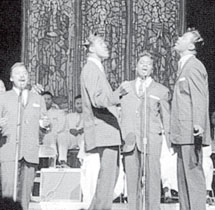Gospel
Music
The heartfelt voice of rural and
urban America reached out to give praise and a new music
was born, and this music was called "Gospel."
 |
The term
"Gospel music" applies to a body of music that was
developed in the United States during the twentieth century
primarily in the south-eastern part of the country and in
portions of the Midwest and the East. It is a Christian music
that was not necessarily developed by the body of churches, but
independently. In other words, the singers and performers were
primarily church-going, Bible-believing |
Christian people, but
their music wasn't always directly an outgrowth of a church
organization.
There are three
styles of gospel music that were developed. These styles were
developed independently of each other because of racial and
physical separation.
1) The mountain gospel style developed in the
Southern Appalachian mountains in Kentucky,
Southwestern Virginia, Northeastern Tennessee, and Northwestern
North Carolina. This music (in the past called "hillbilly
music") sprang forth from a deeply religious people living deep in the hills. Bible-believing and devoted,
religious music formed a major part in the life of these rural
peoples not only in their worship services, but as a part of
their daily existence also. For simplicity sake, the DoveSong
website talks about two types of mountain music: 1) the
traditional style that was passed down and developed during the
twentieth century and 2) the bluegrass style that was
developed by Bill
Monroe and his Blue Grass Boys, including Earl
Scruggs and Lester Flatt.
2) Black
Gospel music originated in the final third of the nineteenth
century with black "jubilee" groups that were formed
in colleges primarily located in the Southeastern United States.
These groups worked with quartet singing, with four-part
harmony. One of the earliest and certainly the most successful
of these groups was the Fisk University Jubilee singers. The jubilee
style of singing continued, while evolving, well into the 1940s.
Meanwhile, a tradition of church singing and composition was
pioneered by such people as Charles Albert Tindley, Lucie
Campbell, W. Herbert Brewster and Kenneth Morris, but reach a zenith
with Thomas A. Dorsey who began using the term "gospel
music" in the 1930s and in conjunction with such singers as
Roberta Martin, Mahalia Jackson, Robert Anderson and Sally
Martin, gave birth to a new style of gospel music that
developed in Chicago and in other mid-western and eastern cities.
Some jubilee quartets evolved into a harder singing style of the
1940s and 1950s. These were groups such as the Blind Boys of Mississippi,
the Soul Stirrers and the Sensational Nightingales. During the
1970s, black gospel music moved primarily into another
direction, pioneered by the great gospel singer James Cleveland.
The style of gospel singing is called mass
choir singing. This movement produced some great, and some
not so great, music well into the 1980s when black gospel music began
to more and more mimic the soul music of the secular world.
Except for the few older groups that continued the older styles,
what was originally black gospel music had been greatly obliterated by the 1990s, and now what you will find in the
record stores, and called "gospel music," has little
or no resemblance. The Positive Music Archives focus on the
great black gospel music up through the 1960s, and those groups
that have maintained these traditions.
3) The third
category of gospel music is called Southern Gospel Music.
This form of music originated at the turn of the century in the
Southeastern United States with sacred quartet singing by white
groups. The pioneer of this music was the Tennessee-resident James D.
Vaughan, who created the first major white sacred quartet,
then established a publishing company to make and sell books of
the quartet music, including his own compositions. An offshoot of this
company was the Stamps Music Company, and the Stamps Quartet.
Quartets sponsored by both the Vaughan and Stamps companies began recording in the late twenties.
From this
nucleus, many other quartets were formed, often working for
Vaughan or Stamps and using the name Vaughan Quartet or Stamps
Quartet. However, in the 1940s, many new groups sprang up, some
former Stamps or Vaughan groups. Thus a great tradition of
quartet singing was perfected by the Blackwood
Brothers, the Statesmen Quartet, the Rangers Quartet, the
Harmoneers, and the Homeland Harmony Quartet. The quartet style
of singing continued into the 1960s when another stream of
southern gospel music developed best described as family
groups. The first of these groups actually stem back to the
1930s with the Carter family group known as the Chuck Wagon
Gang. In the 1940s, the Spear
Family and the Chuck Wagon gang became very popular. The
family group tradition came into full fruition and by the 1980s
and 1990s was thriving in the Southeast United States. Family
groups are gospel groups
that may or may not sing four-part harmony, and are mainly
groups comprised of family members (for example mom and pop, and
the kids). This tradition fortunately still thrives today in
the Southeastern U.S. and, along with mountain and bluegrass styles, is one
of the few positive music traditions that remains in this
country.
->
Gospel
Music in the DoveSong MP3 Library
|

